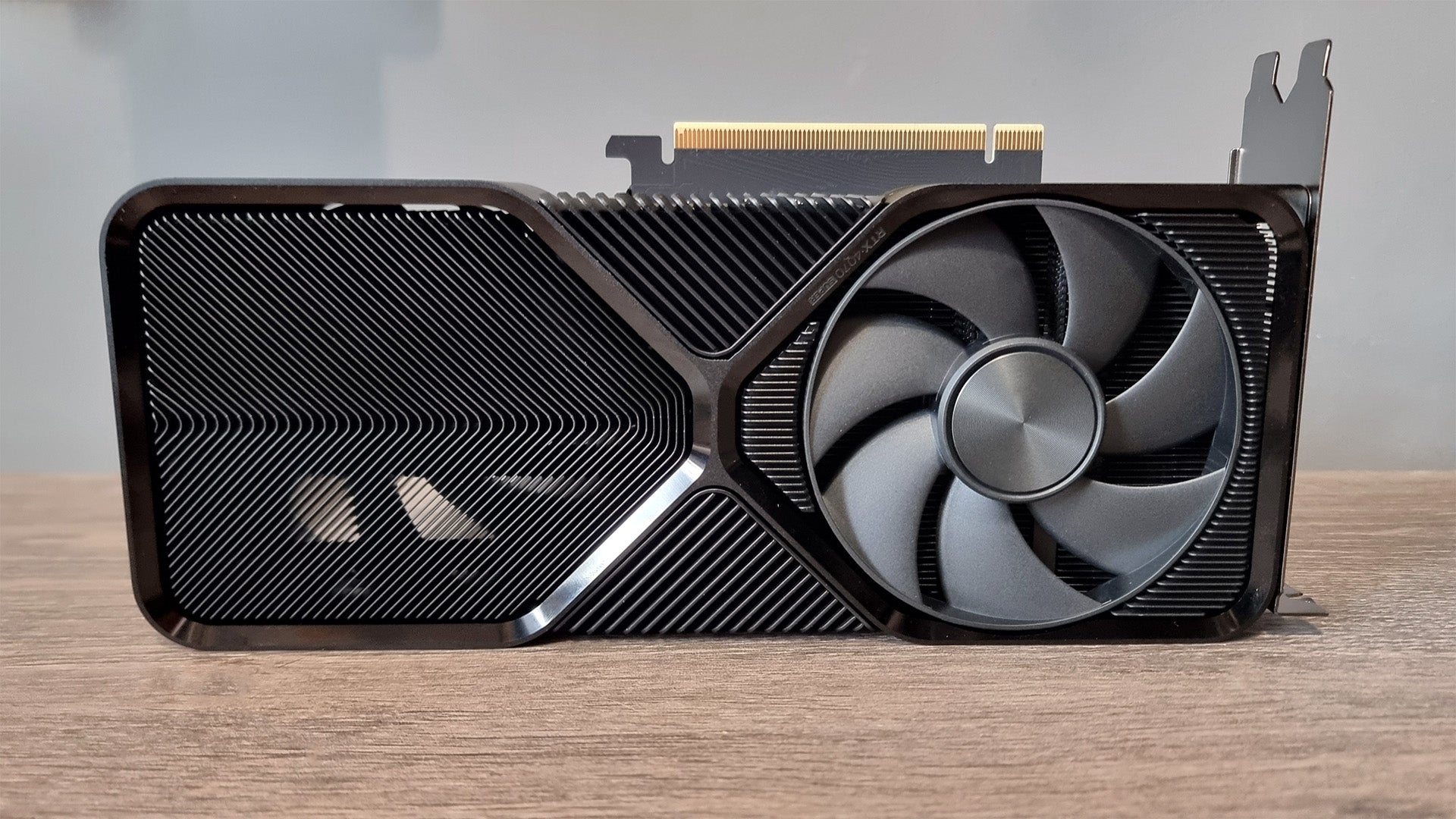AMD Radeon RX 6600 XT Review
The cheapest graphics card in AMD's latest range
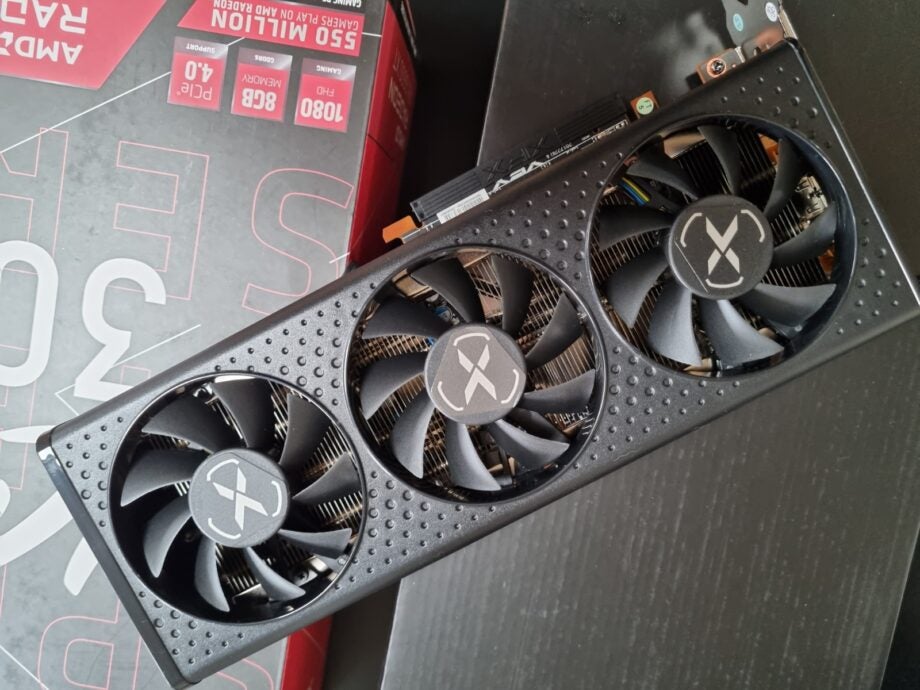

Verdict
The AMD Radeon RX 6600 XT is AMD’s most affordable current-generation graphics card, proving to be an excellent choice for gamers who are on a budget and want high-end features such as ray tracing. But it doesn’t quite do enough to fully dethrone the Nvidia RTX 3060 Ti, which offers decent performance gains in some titles, despite only costing a fraction more.
Pros
- Strong 1080p performance
- Low power consumption
- Wealth of features for Ryzen builds
Cons
- Struggles with ray tracing without FSR activated
- Not as powerful as Nvidia RTX 3060 Ti
Availability
- USARRP: $379
Key Features
- RDNA 2 architecture:Built on AMD’s latest-generation graphics architecture
- Supports ray tracing:Can render ray tracing light effects on compatible games
- FidelityFX Super Resolution:Supports FSR, which helps improve frame rates when running demanding processes
Introduction
The AMD Radeon RX 6600 XT is AMD’s latest attempt to create the ultimate GPU for 1080p gaming. This puts it in the same price bracket as Nvidia’s stellar RTX 3060 Ti.
Featuring RDNA 2 architecture, the RX 6600 XT supports some high-end features despite its low price, with the most noticeable being ray tracing.
Having thoroughly tested and benchmarked the card, I can confirm the AMD RX 6600 XT is an excellent value GPU, and an ideal choice for any gamer on a budget. The only downside is that, despite only costing $30 more, the Nvidia RTX 3060 Ti offers better performance in a few key titles.
Specs
- Built on RDNA 2 architecture
- Supports high-end features such as ray tracing
- Weakest graphics card in AMD’s RDNA 2 family
The AMD Radeon RX 6600 XT is currently at the bottom of AMD’s current generation of GPUs, sitting below the more expensive RX 6800 I tested last year.
This means it retains the core selling points of RDNA 2, which is the same architecture used to run the PS5 and Xbox Series X/S games consoles. These include support for ray tracing light effects on compatible games, Smart Access Memory technology, Infinity Cache tech, plus support for the newly added FidelityFX Super Resolution.
Ray tracing is an advanced technology Nvidia took mainstream when it launched its 20-series graphics cards in 2018. The tech lets GPUs render significantly more realistic lighting effects, such as real-time reflections and shadows. It may not sound exciting on paper, but in reality it makes games feel far more immersive.
The only downside is that ray tracing is super-demanding. To the point the tech can halve frame rates if settings are maxed out in compatible games.
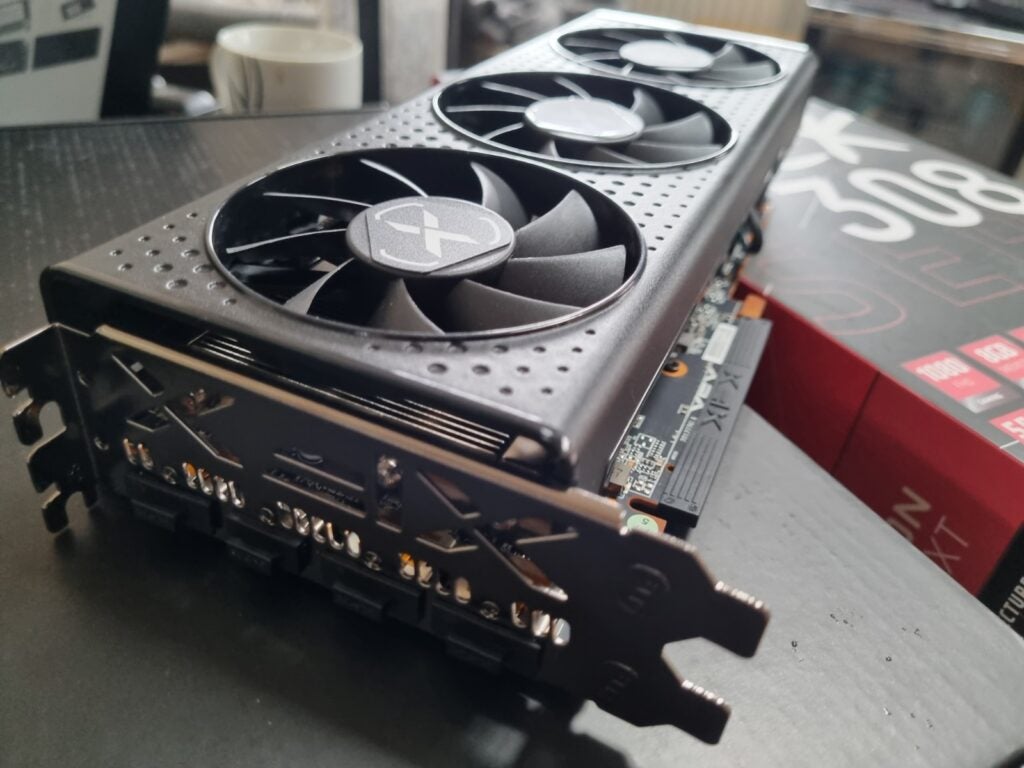
Last year, Nvidia cards had a significant lead on those of AMD because they featured a complimentary technology, known as DLSS, designed to help mitigate ray tracing’s impact on a game’s frame rates.
AMD’s FidelityFX Super Resolution (FSR) aims to offer similar services to DLSS, although it works in a slightly different way. Unlike DLSS, which uses advanced machine-learning tech to enable the GPU to predict and enact workloads more efficiently, FSR uses simple spatial upscaling to improve frame rates while ray tracing. AMD claims that adopting this technique, FSR will be easier to implement and will run on a more diverse portfolio of hardware than DLSS.
Infinity Cache is a custom AMD tech designed to reduce the amount of heavy-lifting the card’s VRAM and Ray Accelerator does by storing more of the data required for ray tracing locally. AMD claims this lets RDNA 2 offer a 50% performance-per-watt improvement on the previous-generation GPUs across the board.
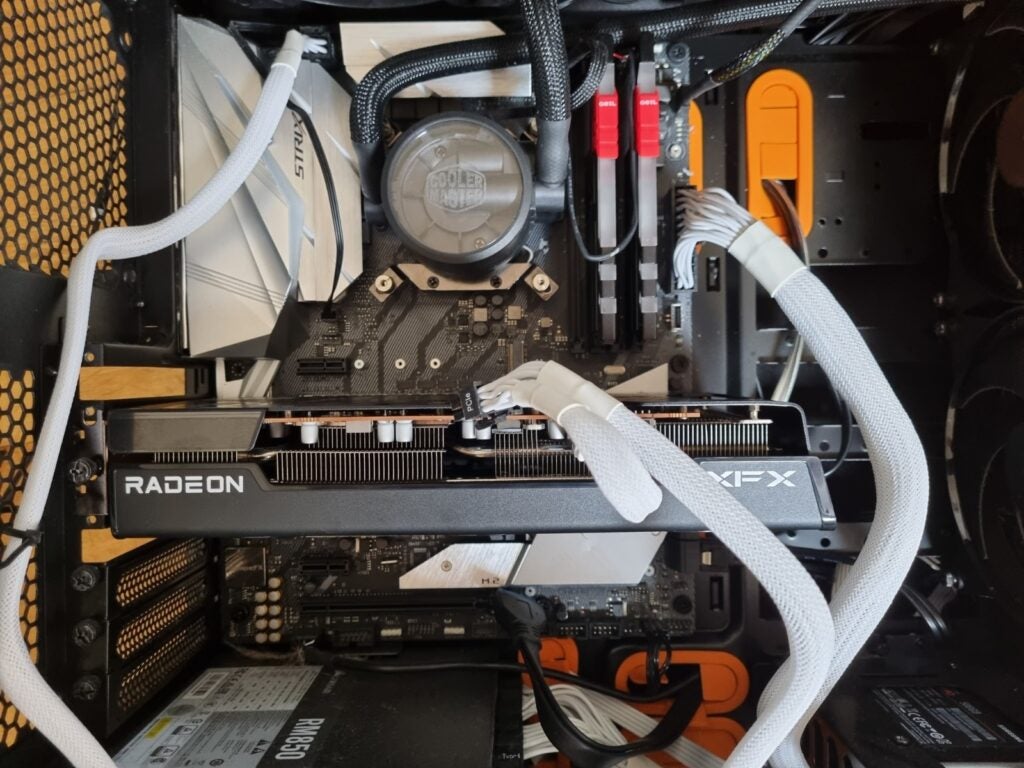
Smart Access Memory technology is another AMD exclusive that aims to let the firm’s RX graphics cards and newer Ryzen CPUs work more efficiently together. Sadly, I didn’t have a compatible CPU on hand during testing. I’ll update this review once I can get back into our office and re-benchmark the card in a Ryzen build.
Outside of this, the AMD Radeon RX 6600 XT’s specs and design are in line with what you’d expect from a GPU at this price. The XFX Quick 308 Black version of the RX 6600 XT I tested comes is a three-fan design that makes the FE 3060 Ti look dinky – although there are smaller micro-ATX-friendly versions available. Around the back, it has the standard selection of ports you’d expect, including two HDMI 2.1 ports and two DisplayPort 1.4 outputs. This means it has all the connectivity you’ll need to connect it to a top-end gaming monitor, TV or VR headset.
In terms of specs, the RX 6600 XT is impressive and holds its own against the RTX 3060 Ti, coming with a lower 160W TDP (power consumption), higher clock speeds and equivalent 8GB of VRAM. Comparing ray tracing performance on paper between it and the 3060 Ti is hard, since the two perform the process in different ways. However, the included 32 compute and Ray Accelerators (the part of the card that runs ray tracing processes) make it fairly good value for money on paper.
The only obvious downside compared to more expensive AMD cards is that it supports only 32MB of Infinity Cache. You can see a more thorough breakdown of its core specs in the table below.
| Card | Price | VRAM | Core clock speed | Boost clock speed | Tensor Cores | RT Cores | RDNA Compute Units | TGP |
| Nvidia RTX 3090 | $1499 | 24GB GDDR6x | 1395 MHz | 1695 MHz | 328 | 82 | NA | 350W |
| Nvidia RTX 3080 Ti | $1199 | 12GB GDDR6x | 1365 MHz | 1665 MHz | 320 | 80 | NA | 350W |
| AMD RX6900 XT | $999 | 16GB GDDR6 | 1825 MHz | 2250 MHz | NA | NA | 80 | 300W |
| Nvidia RTX 3080 | $699 | 10GB GDDR6x | 1440 MHz | 1710 MHz | 272 | 68 | NA | 320W |
| AMD RX 6800 XT | $649 | 16GB GDDR6 | 1825 MHz | 2250 MHz | NA | NA | 72 | 300W |
| Nvidia RTX 3070 Ti | $599 | 8GB GDDR6x | 1575MHz | 1770MHz | 192 | 48 | NA | 290W |
| Nvidia RTX 3070 | $499 | 8GB GDDR6 | 1500 MHz | 1730 MHz | 184 | 46 | NA | 220W |
| AMD RX 6800 | $579 | 16GB GDDR6 | 1700 MHz | 2105 MHz | NA | NA | 60 | 250W |
| AMD RX 6700 XT | $479 | 12GB GDDR6 | 2424 MHz | 2581 MHz | NA | NA | 40 | 230W |
| Nvidia RTX 3060 Ti | $399 | 8GB GDDR6 | 1410 MHz | 1665 MHz | 152 | 38 | NA | 200W |
| AMD RX 6600 XT | $370 | 8GB GDDR6 | 2359MHz | 2589MHz | NA | NA | 32 | 160W |
Performance and benchmarks
- Solid 1080p performance across the board
- Can’t quite compete with the Nvidia RTX 3060 Ti
- Struggles with ray tracing without FSR activated
As I’ve said numerous times before, however, clock speeds are no longer indicative of overall performance. This is the reason we always test a card using a series of in-game and synthetic benchmark tests to accurately gauge they’re speed.
Specifically, I ran the AMD Radeon RX 6600 XT through a series of synthetic and in-game tests using a rig with the below components.
Test rig specs:
- Asus ROG Strix Z370-E Gaming (LGA1151)
- Intel Core i9-9900KF
- 16GB DDR4 RAM
- Samsung SSD 860 EVO 500GB SATA SSD
- Corsair RM750X PSU
- MasterLiquid Pro 280 cooler
Every game we tested had its graphics settings maxed out. You can see how the AMD Radeon RX 6600 XT performed in each test below.
Godfall
| Ray tracing off / FSR off | Ray tracing on / FSR off | Ray tracing on / FSR on | |
| 4K | 32.8 fps | 9.2 fps | 13 fps |
| 1440p | 63.4 fps | 14.2 fps | 36.6 fps |
| 1080p | 89.7 fps | 19.9 fps | 72.6 fps |
Godfall is an AMD-optimised action RPG that supports FSR and ray tracing. It isn’t a terribly good game to play, but it’s a great showcase for ray tracing, featuring huge sprawling environments full of reflective surfaces. Its internal benchmark is a good gauge to check how a GPU will run most modern triple-A RPGs.
Here, the game revealed quite how good FSR can be. Playing the game with ray tracing on the new tech tripled Godfall’s frame rate. Without it, the card couldn’t play Godfall at acceptable frame rates with support for ray tracing turned on.
Control
| Ray tracing off | Ray tracing on | |
| 4K | 37 fps | 2 fps |
| 1440p | 76 fps | 22 fps |
| 1080p | 116 fps | 39 fps |
Control was one of the first games to support ray tracing. It remains a showcase for how great the tech can look, featuring multiple reflective environments and wonderfully complex physics. It’s a great game to gauge how a GPU will handle hardcore ray tracing as a result. Control doesn’t support FSR or feature an internal benchmark; we gauge performance by recording the average frame rate running through a specific section of the game
Here, once again, the RX 6600 XT managed to play the game at playable frame rates at every resolution with ray tracing off, only falling below 60fps in 4K. But ray tracing performance lagged, with it failing to play the game at post-60fps in any resolution.
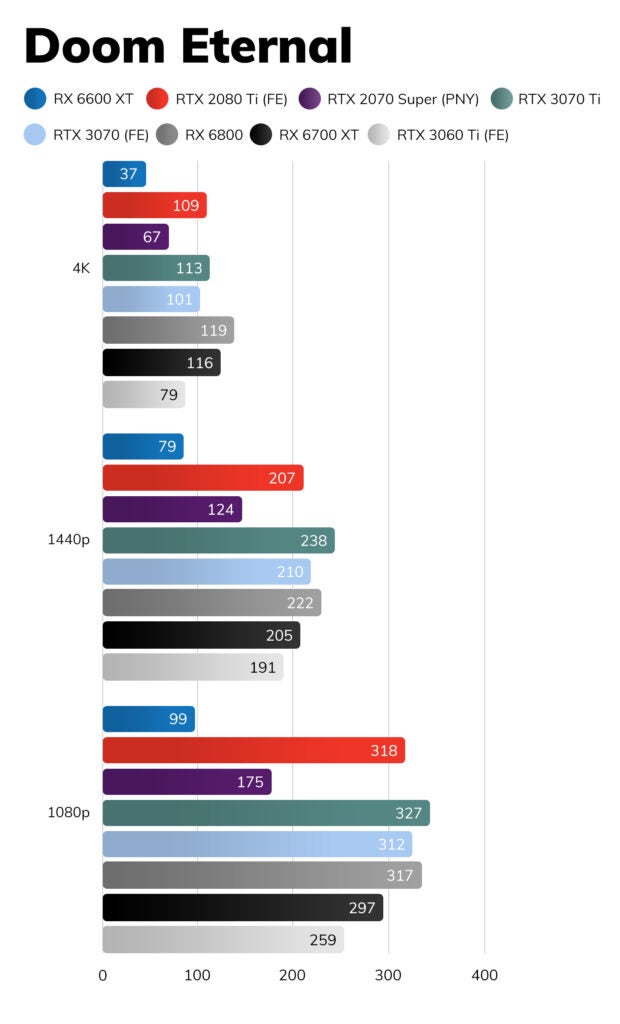
Doom Eternal
Doom Eternal is a wonderfully designed game that runs in the Vulkan, not the more common DirectX API. It’s also just been updated to support ray tracing, making it a great metric to gauge how a GPU will handle most first-person shooters. Doom Eternal doesn’t have an internal benchmark, so we evaluated performance by recording the average frame rate running through a section of the opening level of the gam
Here, the RX 6600 XT performed well, playing the game at playable frame rates at every resolution; but the scores were noticeably lower than those achieved by the 3060 Ti.
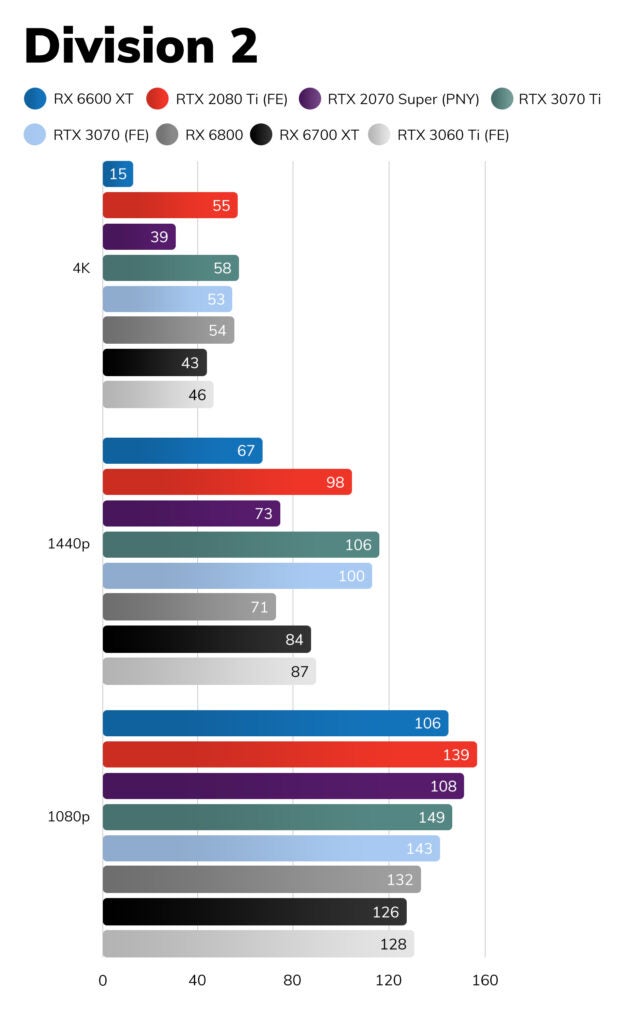
The Division 2
The Division 2 is one of Ubisoft’s live service games. It’s a third-person multiplayer shooter set in a post-apocalyptic America. The game has fairly low system requirements, but The Division 2’s internal benchmark remains a solid metric to gauge how well a GPU will run most modern live service games. Here, the RX 6600 XT performed well in every resolution other than 4K.

Borderlands 3
Borderlands 3 is an AMD-optimised multiplayer, first-person shooter. The game doesn’t support ray tracing or FSR, but its large open-world is full of demanding particle effects, explosions and NPCs. This makes its internal benchmark a good indicator for how well a GPU will handle most modern triple-A games. Here, the card performed well, breaking the 60fps milestone in every test, other than 4K.
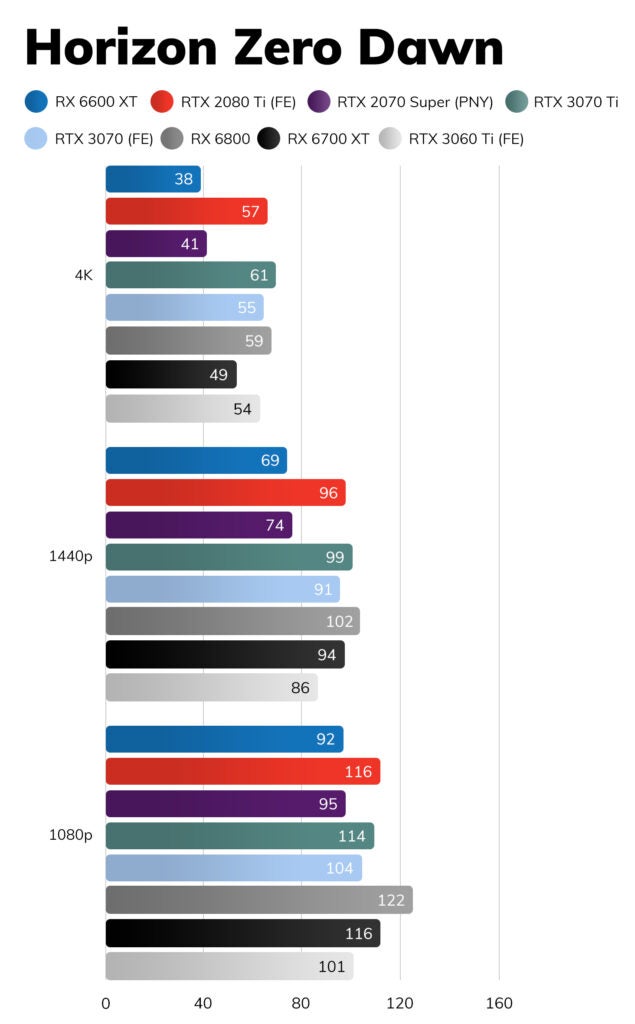
Horizon Zero Dawn
Horizon Zero Dawn is a former PS4 exclusive. It’s a beautiful, but terribly optimised, game that really puts any system through its paces. Its internal benchmark is a good gauge to see how a GPU handles demanding games. The 6600 XT performed well in 1080p and 4K, but dropped below 60fps in 4K. Once again, it also fell slightly behind the RTX 3060 Ti.
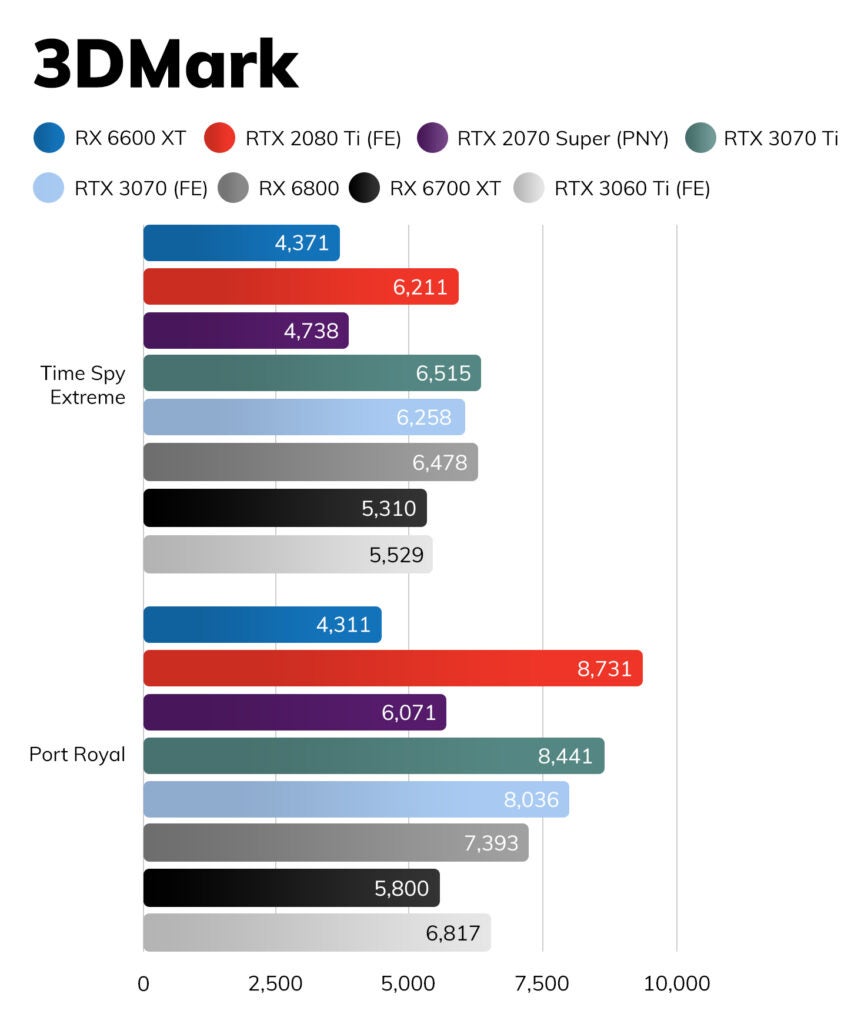
3DMark
3DMark is a synthetic benchmarking tool. The Time Spy Extreme test we use aims to evaluate a GPU’s Direct X 12 4K gaming performance. Port Royal is a test designed to determine how well a GPU handles ray tracing. In both tests, a higher score is better.
The Time Spy Extreme score showed the 6600XT to offer near-equivalent performance to Nvidia’s previous generation RTX 2070 family of cards. This puts it behind the 3060 Ti, which scored noticeably better.
The Port Royal score was atypically lower than I expected considering the card’s specs. An AMD spokesperson told me this is due to an issue with the pre-release drivers I had to use during testing. I’ll re-bench the card and update the results once the firm releases its final consumer drivers.
Overclocking and power consumption
- Not much room for overclocking
- Very low power consumption compared to rivals
Third-party cards tend not to be that overclockable, since the OEMs push the card’s speeds at a factory level. This is the reason I wasn’t terribly surprised to find my XFX review unit wasn’t overclockable.
Doing a rough-and-ready overclock, I was able to only get a stable 6% performance boost on the card’s clock speed and 2% boost to its memory. This didn’t lead to any serious performance gains in game.
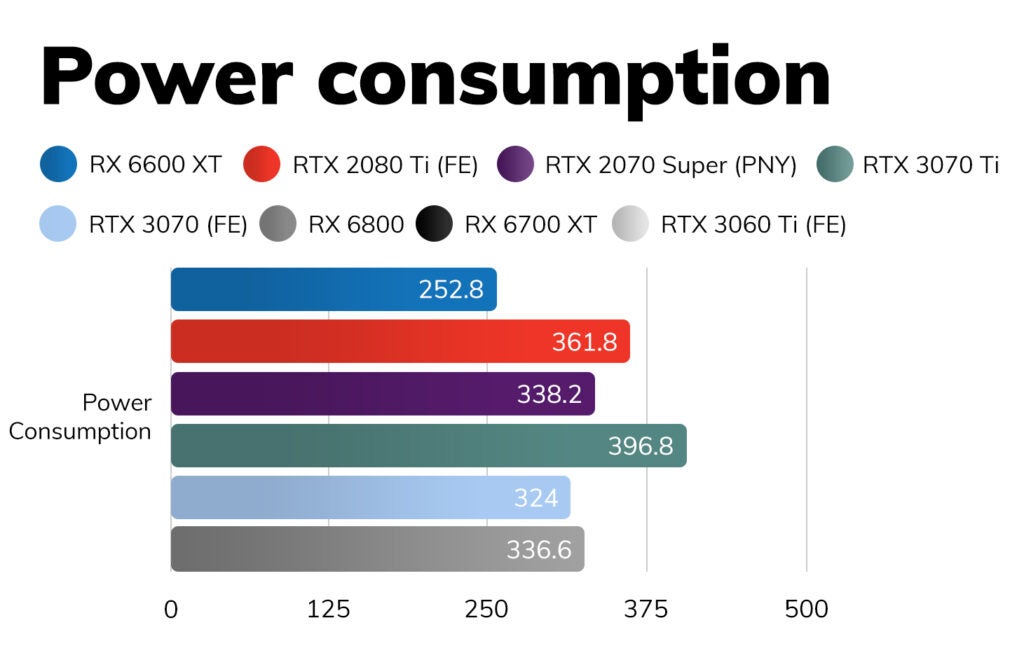
The card’s focus on the 1080p segment of the market and lower specs mean the RX 6600 XT doesn’t require much power to run. During testing, I detected a peak system draw of 252.8W running the Time Spy Extreme benchmark. This makes it significantly less demanding than the RTX 3060 Ti, and an excellent option for buyers looking to upgrade a system with a low-capacity PSU.
Best Offers
Should you buy it?
If you want a graphics card for 1080p gaming: The RX 6600 TX is a great card for any gamer looking to enjoy next-generation gaming in 1080p. During testing, the card ran every game we threw at it in 1080p with zero hassle.
If you want to play games above 1080p: During testing, the RX 6600 XT struggled to play demanding titles at higher resolutions than 1080p, especially with support for ray tracing turned on.
Final Thoughts
The AMD Radeon RX 6600 XT is a great graphics card for 1080p gaming. Although it doesn’t quite match the performance of the moderately more expensive Nvidia RTX 3060 Ti, it remains great value for money thanks to its lower TDP and reliable FHD performance. The inclusion of FSR also helps it remain competitive with ray tracing graphics active. However, it struggles to run games at higher resolutions, so if you plan to game in 1440p or above, then you’ll have to spend more on a card such as the RX 6700 XT or RTX 3070.
How we test
Every graphics card we review is run through a series of synthetic and real world benchmarks to gauge its performance, power efficiency and potential for overclocking.
Tested with in-game benchmarks
Power consumption checked
Compared against other cards we’ve tested
Overclocked to gauge potential performance boosts
FAQs
The RX 6600 XT is built on AMD’s RDNA 2 architecture, which means it supports ray tracing on compatible titles.
The RX 6600 XT does support AMD’s FSR, which helps improve frame rates when running demanding processes such as ray tracing.
During our tests, the RX 6600 XT managed to play some titles in 1440p with ray tracing turned off, but struggled in 4K.



